Have you ever wondered why some behaviors or some of the things you do seem innate or unconscious? Interestingly enough, a lot of these intuitive gestures have evolved over many years in order to aid in our socialization and overall survival!
Our social thoughts and attitudes don’t just have a big impact in how we view and treat ourselves, but conversely also in the way others perceive and view us! Likewise, it also affects how we view and treat others as well!
This chapter overview will cover some of the basic concepts of attitude and social thinking which will help you when covering our more in depth articles. Let’s go!
Social Thinking and Attitude on the MCAT: What You Need to Know
Topics on social thinking and attitude will be tested on the Psych/Soc section of the MCAT and can appear both as passage based and fundamental discrete questions.
Here at MCAT Mastery, we’ve calculated that about on average you can expect around 5-7 questions on the MCAT exam that will cover topics on social thinking and attitude
Introductory psychology accounts for 65% of the content covered in the Psychological, Social, and Biological Foundations of Behavior while introductory sociology covers about 30 of the content.
Important Sub-Topics: Social Thinking and Attitude
It’s important to note that social thinking and attitude is much more about our inherent behaviors and ways of thinking and how these innate manners are commonly present throughout individuals!
Contrast this to topics on social processes and behavior which still focuses on individuals’ behavior, but is more focused on how our individual behavior is influenced by the presence of others such as in a group setting!
1. Inherent Attraction, Aggression, Attachment and Support
In general, the above mentioned terms are some of the most commonly seen inherent behaviors seen in humans! Evolutionary speaking, it’s most probable that these traits developed in order to aid in our social skills which in turn promoted our survival!
We’ve all been attracted to someone at some point — whether it’s in an admiring way like when a kid looks up to a professional athlete or in a “crush-crush” way 
There are many factors that contribute to attraction such as similarities and reciprocity, but an interesting phenomenon that’s been observed is the proximity and mere exposure effect — simply put, the closer in distance you are to someone and the more frequently you interact with them, the higher the likelihood of attraction!
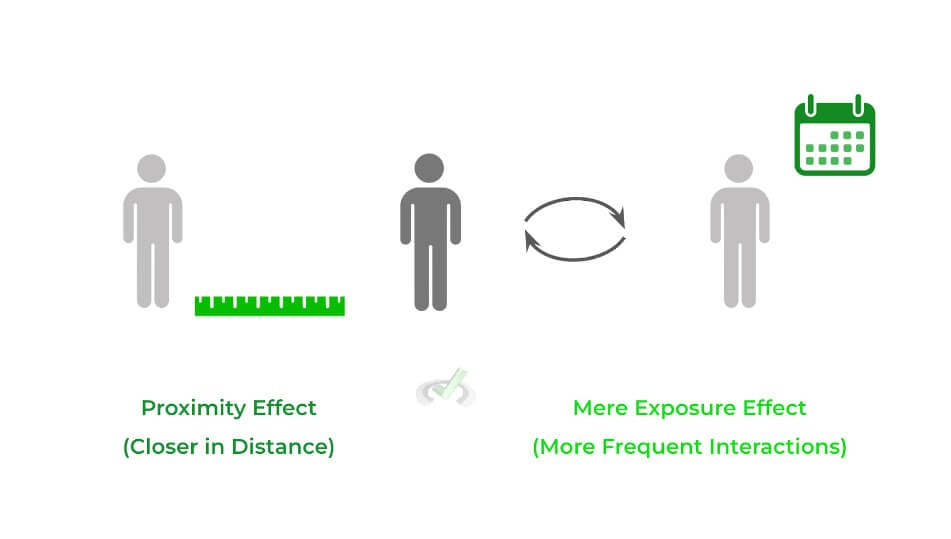
On the opposite spectrum of attraction is aggression, which is the innate behavior of individuals to initiate harm and social dominance. While on the surface, aggression is usually viewed in a negative light, it may have evolved as a way to combat threats!
From a neurobiological view, the amygdala is highly responsible for our recognition and projection of aggression. Oftentimes, our want to display aggression is innate; however, the amygdala is in constant communication with the prefrontal cortex.
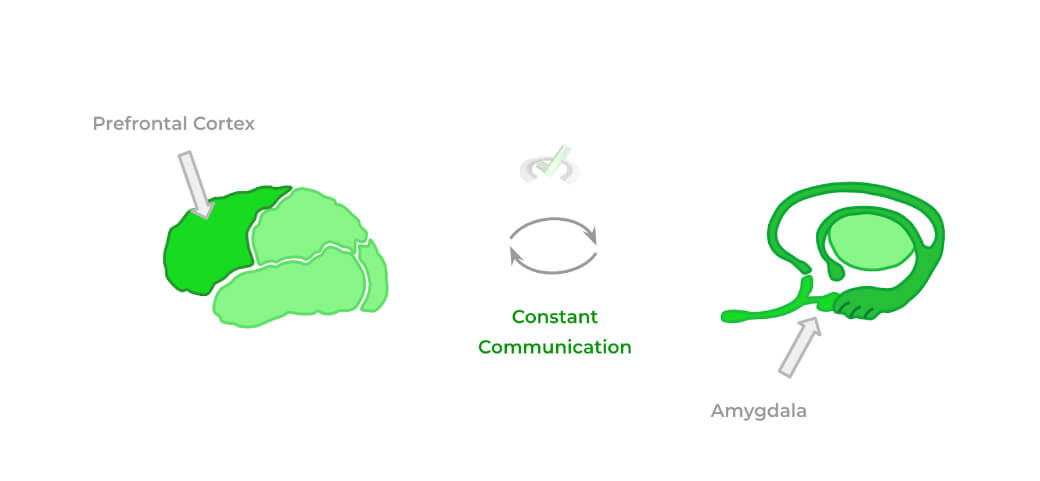
Recall that the prefrontal cortex is responsible for our decision making and planning function. As such, it helps to “hold back” the innate want to display aggression in times of stress and helps us make decisions based on rational rather than emotion and impulsiveness.
A related concept to attraction is attachment, which also stems from positive feelings but is more concerned with the development of an emotional bond and — more importantly — a sense of security.
There are various attachment styles that can stay with us until adulthood and the type that we develop can actually depend on how we were treated by our main caregiver as an infant. In fact, there are 3 main attachment styles that have been observed: secure, anxious-insecure, and ambivalent-insecure:
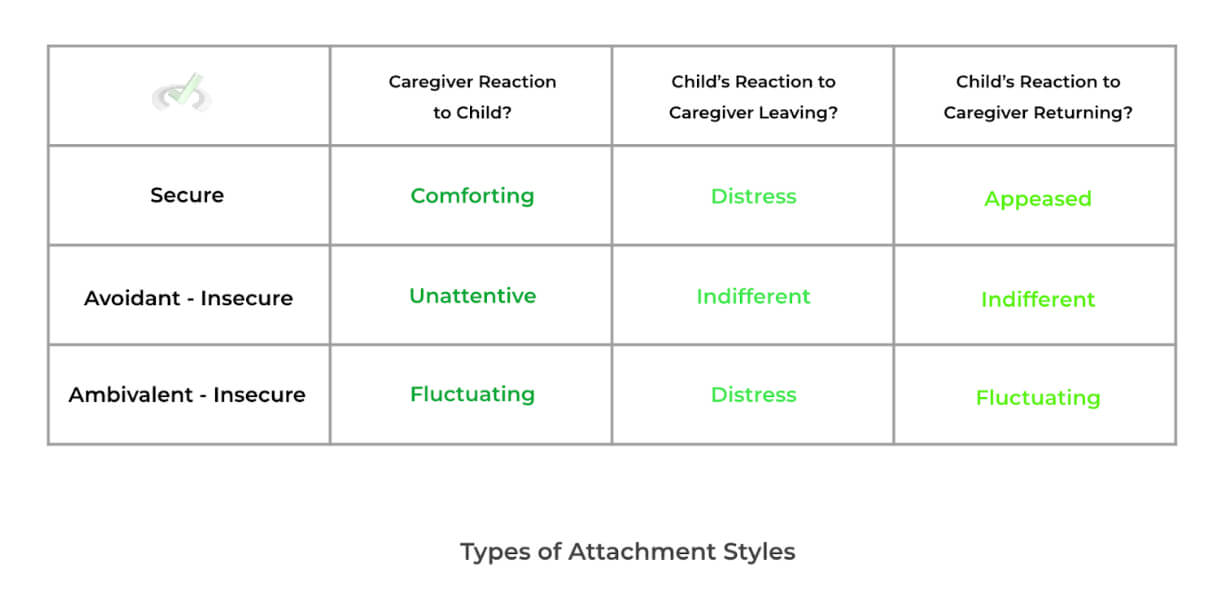
It’s definitely important to note that attachment styles can change over the course of maturing and time! Additionally, there’s another attachment style called disorganized attachment, but is not heavily emphasized as opposed to the other 3.
Finally, another inherent behavior we all want to give and receive is social support which refers to the comfort we receive from having a support system which we can lean on in times of need.
Likewise, a big component of social support is its reciprocity: one wishes both to give and receive social support to and from others! There are 5 main types of social support: material, informational, emotional, esteem, and network.
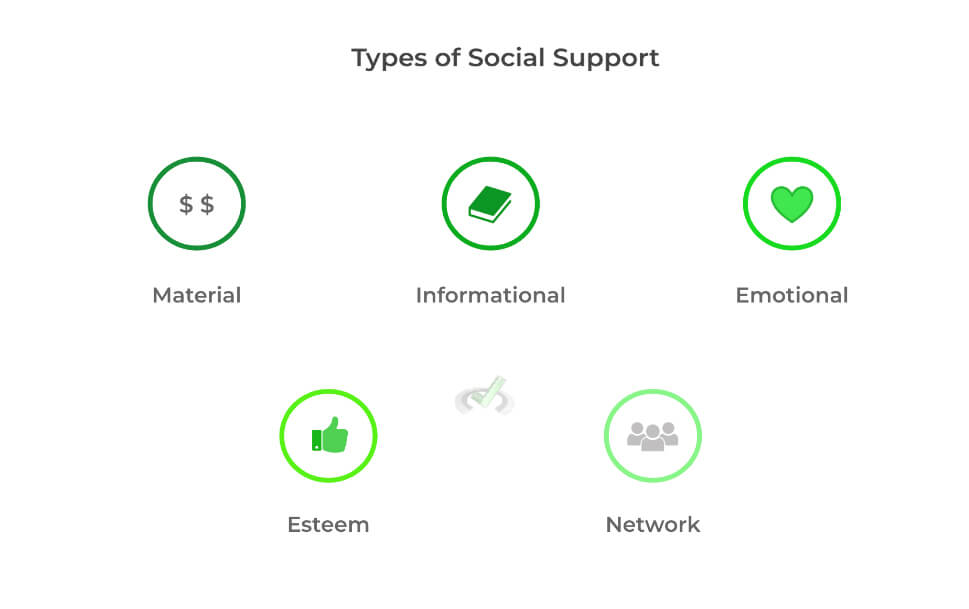
Full Study Notes : Inherent Attraction, Aggression, Attachment and Support on the MCAT
For more in-depth content review on the different types of inherent behaviors, check out these detailed lesson notes created by top MCAT scorers.
2. Evolutionary Benefits of Social Behavior
A big idea about the evolution of favorable social behavior is that it’s been selected to ensure our past selves' survival! It’s the same when an advantageous trait such as venom or camouflage is also selected and favored over the course of evolution.
A big component in the evolution of social behavior is the application of game theory in how social behaviors evolve! If you’ve watched the movie “A Beautiful Mind”, this may sound familiar to you as this was one of the main topics of the movie!
Game theory is a way of studying and predicting the decisions made by individuals hoping to achieve a certain outcome — in the case of evolutionary biology, the outcome is fitness and survival, as well as passing on those traits to offspring.
An important aspect of evolutionary game theory is that all the individuals (“players”) have the goal of maximizing offspring. They’re not just looking to make a decision individually, but are also taking into account the decisions of other individuals in order to have the overall most favorable outcome.
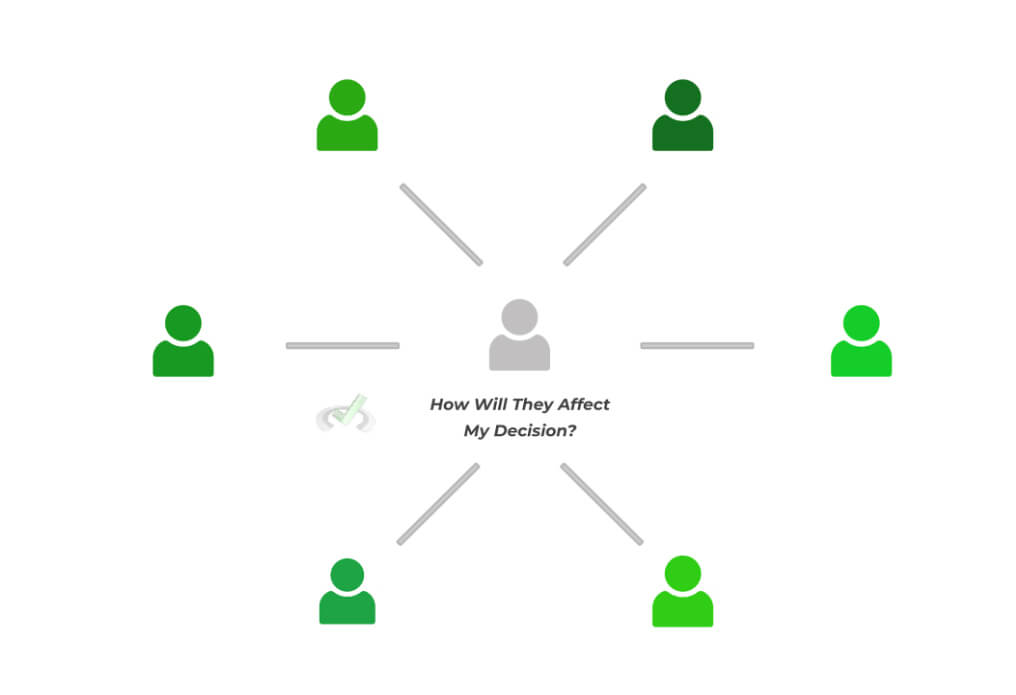
An interesting point about game theory is that it can explain the behavior of altruism, which describes when an organism acts in a way that reduces its own fitness in order to increase the fitness of another individual.
At first, this seems counterintuitive because decreasing one’s fitness decreases its likelihood for survival. However, it’s believed that altruism arises from the belief that reciprocal altruism will occur to the individual.
It’s basically the old “I’ll help you if you help me” scenario: an individual engages in altruism with the belief that other individuals will return that altruistic behavior.
Full Study Notes : Evolutionary Benefits of Social Behavior on the MCAT
For more in-depth content review on the evolutionary background of social behaviors, check out these detailed lesson notes created by top MCAT scorers.
3. Types of Inherent Social Perceptions
In addition to our inherent social behaviors, we also have the innate tendency to judge the behaviors of others and make attributions to those behaviors: attributions are ways to explain why those behaviors occur.
Whether we like it or not, most of us are prone to engage in making attributions. There are 2 main types of attributions that are made: dispositional/internal and situational/external attributions.
The names of the attributions basically define themselves! Dispositional attributions to describe the behavior of another person arising from internal factors and characteristics. Conversely, we use situational attributions to describe external factors which may cause a person to behave in a certain way. Look at the example below!
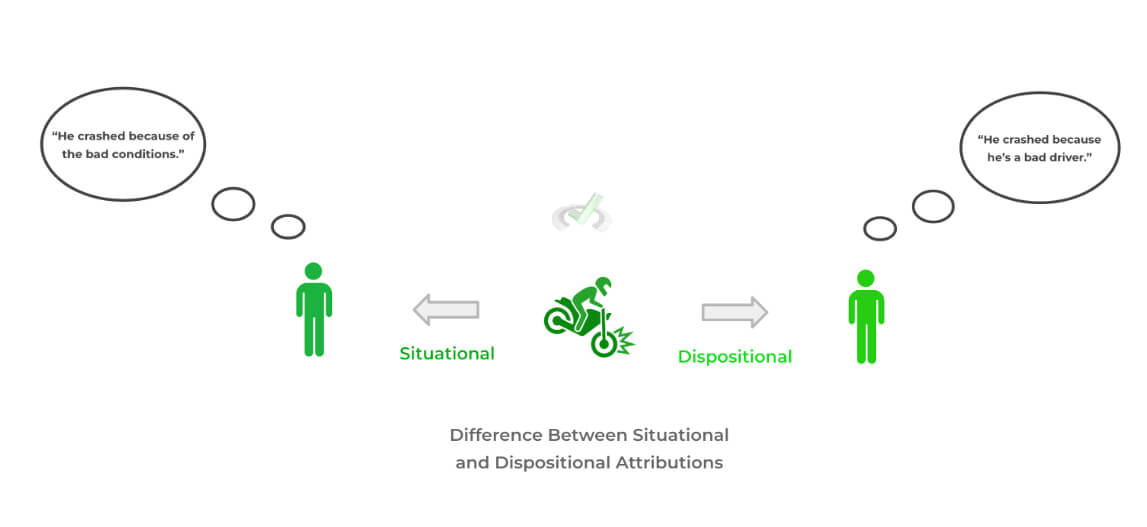
Having covered the 2 main types of attributions, there are a couple of biases that can arise from our innate tendency to make these attributions. Some of the most tested include the fundamental attribution error and self-serving bias!
A commonly tested one is the fundamental attribution error (also called correspondence bias) is our tendency to overemphasize dispositional attributions to describe individuals’ behaviors while underemphasizing situational attributions.
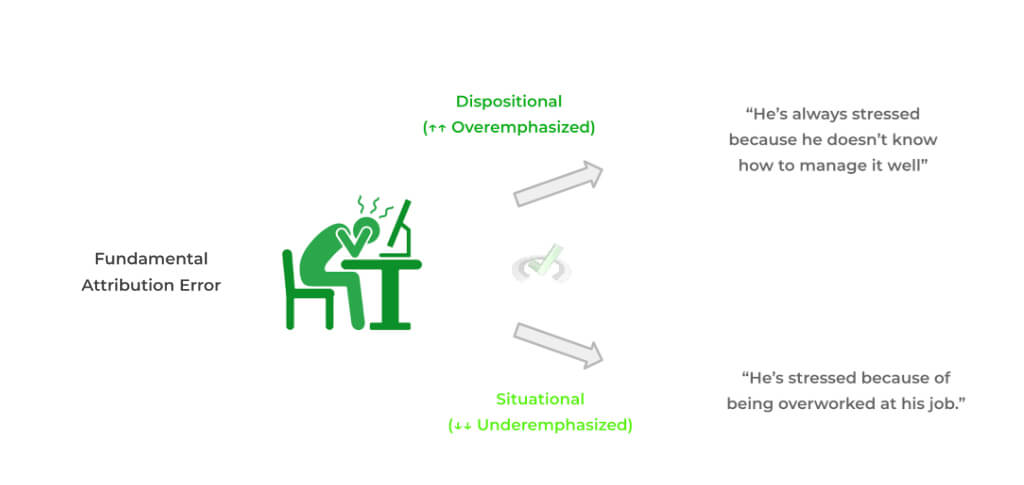
A similar attribution bias that’s also made is the self serving bias! In this bias, we tend to attribute our own positive outcomes to dispositional factors while attributing situational factors to when we receive negative outcomes.
The key idea and component of the self-serving bias is that it’s about our own actions and outcomes! As opposed to the fundamental attribution error, where we’re making attributions about other people, the self-serving bias emphasizes how we perceive the behaviors and events in our own lives!
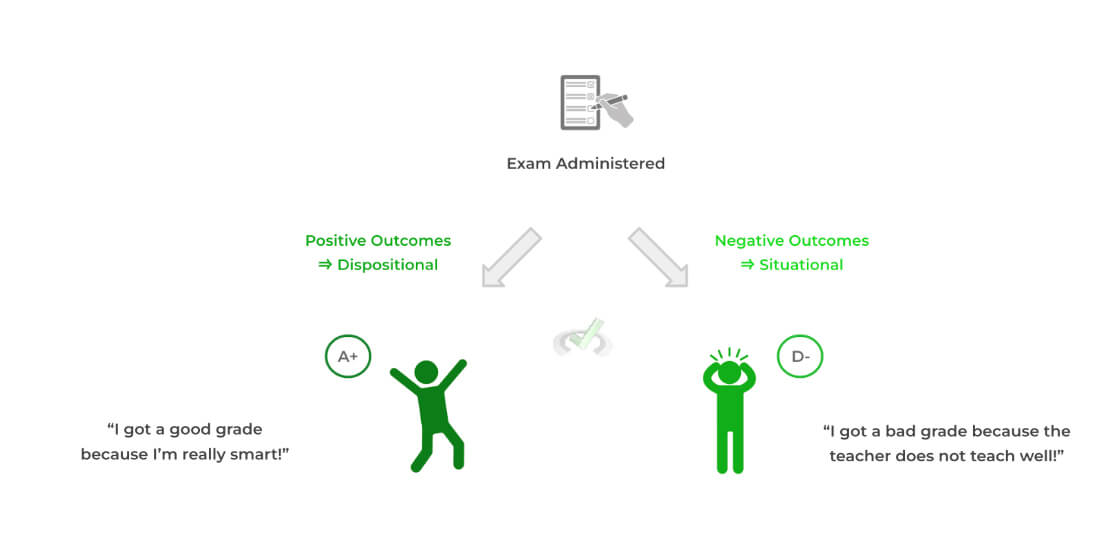
Full Study Notes : Types of Inherent Social Perceptions on the MCAT
For more in-depth content review on some of the main attributional biases we tend to inherently make, check out these detailed lesson notes created by top MCAT scorers.
4. Theories and Components of Attitude
When going into your MCAT prep and eventually going in for your test day, all of us here at MCAT Mastery encourage you to face these experiences with a positive attitude, something we all need more of nowadays!
While we commonly think of attitude as a feeling (which it certainly is), it’s better to think of attitude as a way of perceiving something and attributing a positive, negative, or neutral association towards it. This can take the form of anything from our attitude towards a job, an animal, a life event, etc.
There are 3 main components to an attitude, often called the ABCs of attitude: an affective, behavioral, and cognitive component. It’s pretty similar to how emotion has a behavioral, cognitive, and physiological components: be sure not to mix them up!
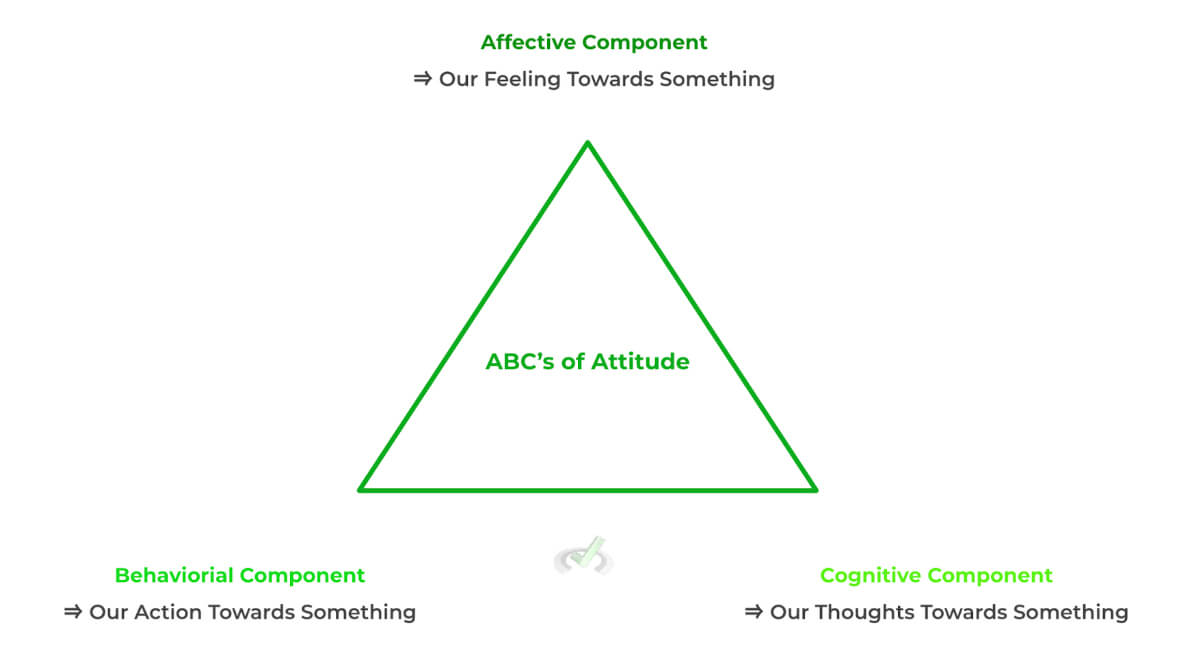
Remember, an important part of the components of attitude is that it’s in reference to something! It’s probably better to put it into context with an example! Let’s look at a common attitude a person might have toward snakes!
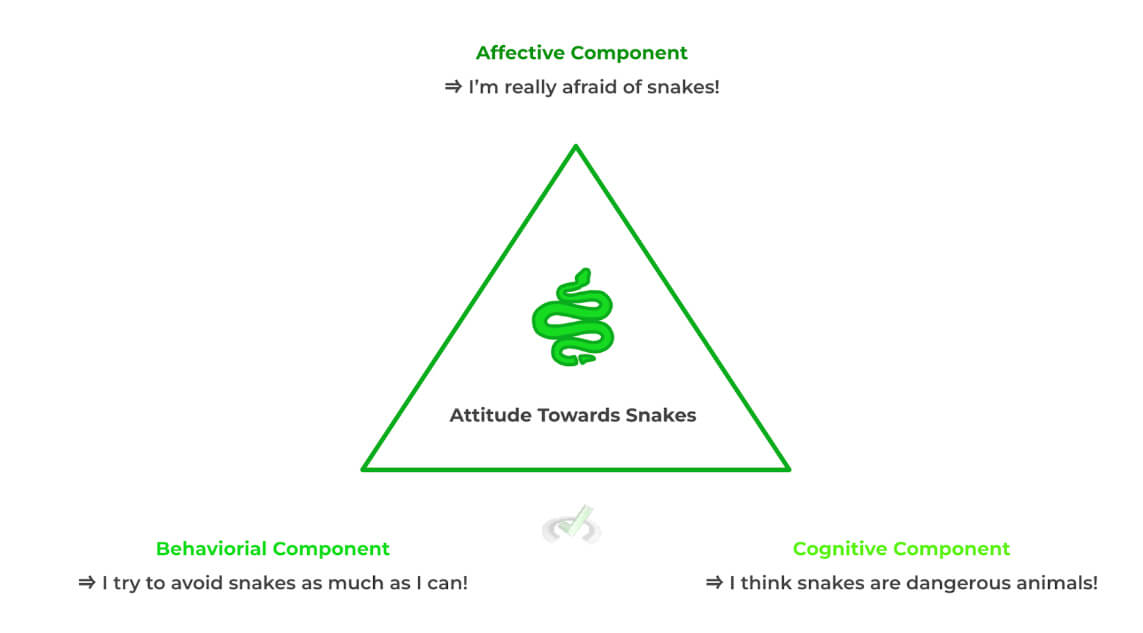
Hopefully, the above figures and examples give y’all a better idea and visualization of the components of attitude!
Full Study Notes : Theories and Components of Attitude on the MCAT
For more in-depth content review on attitude in psychology, check out these detailed lesson notes created by top MCAT scorers.
5. The Effects of Attitude on Stereotype, Prejudice, and Discrimination
An unfortunate consequence of the rise of various forms of social media is the rise of stigmatization, which is an overall negative attitude attributed towards something — usually this is targeted towards a group of people with a specific trait/condition.
Sadly, the components of attitude can also be applied to stigmatization, albeit not in the most positive way. The terms prejudice, discrimination, and stereotype are basically the affective, behavioral, and cognitive components of stigma — remember that stigma itself is an overall negative attribute! Check out the example below.
Disclaimer: We, here at MCAT Mastery, do not condone the examples that we give. We simply give these examples as a way to help explain concepts and terms.
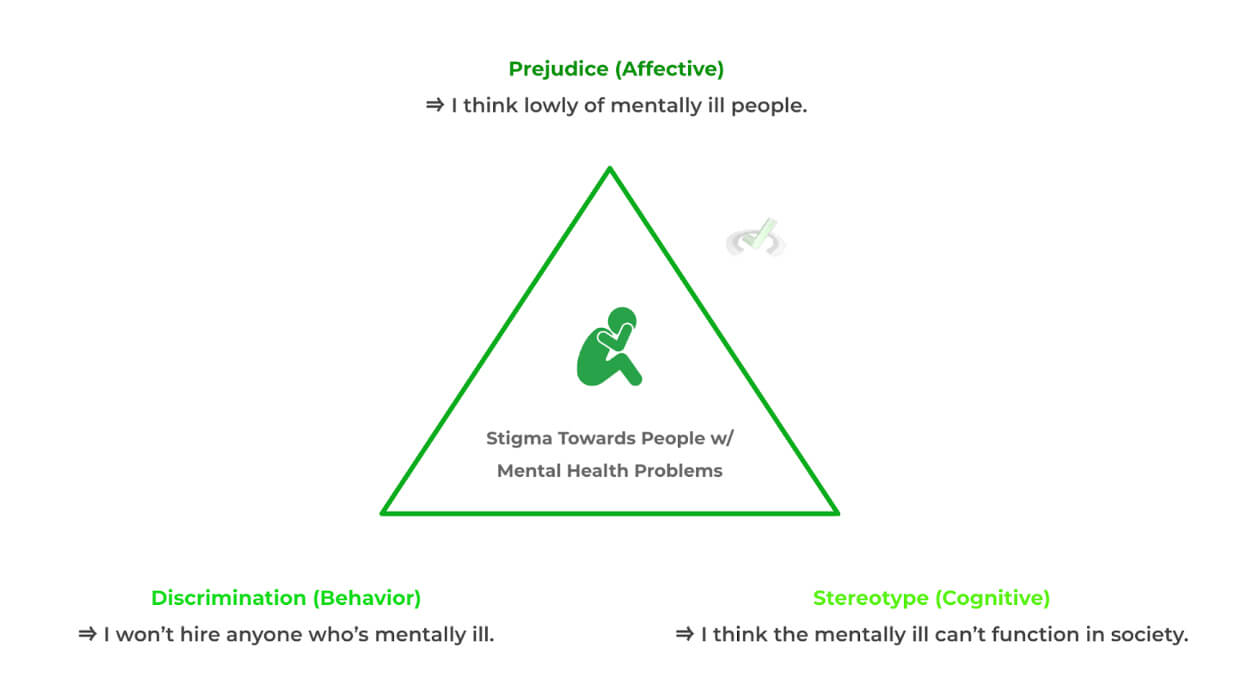
As shown above, each of the terms represents one of the components of attitude, just applied in the sense of stigma.
For more in-depth content review on basic covering of the various aspects of prejudice, discrimination, and stereotype, check out these detailed lesson notes created by top MCAT scorers.
Important Definitions and Key Terms
Below are some high yield definitions and key terms to refer to when reviewing concepts and ideas about social thinking and attitude!
Term | Definition |
|---|---|
Attraction | An inherent liking towards someone which can be influenced by many factors such as similarities, reciprocity, etc. |
Proximity/Mere Exposure Effect | The observation 2 people are more likely to be attracted to each other the closer they are and the more frequent interactions they have |
Aggression | An inherent tendency to cause harm and display social dominance |
Attachment | An inherent feeling similar to attraction, but more focused on creating and maintaining an emotional bond |
Social Support | An inherent feeling we desire to have and give, relying on the comfort we receive (and give) in a social group |
Game Theory | A way of studying how individuals interact in order to achieve an outcome; in this model, individual’s take into account how other individuals will make their decision |
Altruism | A behavior where an organism decreases its own fitness in order to increase the fitness of others |
Situational Attribution | An attribution where we attribute behaviors as being caused by external factors |
Dispositional Attribution | An attribution where we attribute behaviors as being caused by internal factors |
Fundamental Attribution Error | Describes the tendency for individuals to emphasize dispositional attributions to describe others behaviors while minimizing situational attributions |
Self Serving Bias | Describes the tendency for individuals to emphasize dispositional attributions to themselves when positive outcomes occur but emphasize situational attributions when negative outcomes occur |
Attitude | Defined as the way we perceive something and attach positive, negative, or neutral associations towards it; Consist of an affective, behavioral, and cognitive component |
Stigma | A negative attitude and perception that’s attributed towards something, oftentimes a group of people with a specific trait/characteristic |
Prejudice | Refers to the affective component of stigma |
Discrimination | Refers to the behavioral component of stigma |
Stereotype | Refers to the cognitive component of stigma |
Additional FAQs - Social Thinking and Attitude on the MCAT
A. Is Social Psychology on the MCAT?
B. What is Social Cognitive Theory – MCAT?
C. What Are the 3 Components of Attitude?
D. What Are the 3 Components of Social Attitudes?
Additional Reading Links – Study Notes for Social Thinking and Attitudes on the MCAT
Additional Reading:
- Identity and Personality on the MCAT
- Language Development on the MCAT
- Learning and Memory on the MCAT
- Motivation and Emotion on the MCAT
- Neurobiology on the MCAT
- Psychological Disorders on the MCAT
- Sensation and Perception on the MCAT
- Social Interaction on the MCAT
- Social Processes and Behavior on the MCAT
- Social Structure and Stratification on the MCAT



 To help you achieve your goal MCAT score, we take turns hosting these
To help you achieve your goal MCAT score, we take turns hosting these 
























